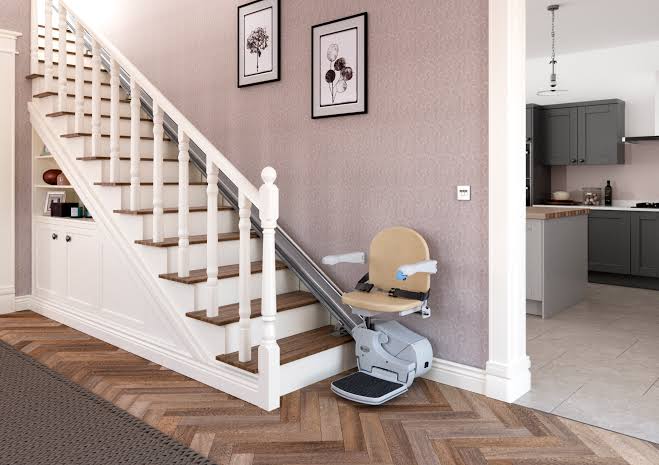The journey toward creating a more accessible home doesn’t have to be overwhelming or complex. With the right tools and innovations, enhancing mobility and safety can transform daily life for individuals with limited mobility. Stairlifts, ramps, and vehicle lifts are just a few of the solutions available that can make a home truly accessible, giving residents the independence and comfort they need. For those in need of professional installation, Stairlift Virginia offers customized solutions to ensure homes are designed with both mobility and convenience in mind.
In this article, we’ll explore a range of modern accessibility solutions, beyond just stairlifts and ramps, that are revolutionizing the way homes are designed and retrofitted to meet mobility needs.
Starting with the Basics: The Role of Stairlifts
One of the most common and effective home accessibility solutions is the stairlift. Designed for individuals who find it difficult or impossible to navigate stairs, stairlifts provide a smooth and safe ride between floors. For multi-level homes, stairlifts are essential for maintaining freedom of movement.
1. Simplicity and Ease of Use
At its core, a stairlift is designed for simplicity. With a simple control system, users can glide up and down stairs at the push of a button. Modern stairlifts are equipped with safety features such as swivel seats, seat belts, and obstruction sensors, making them easy and safe for anyone to use.
Whether the staircase is straight, curved, or even outdoors, there’s a top-rated stairlift solution available that can be tailored to fit the specific dimensions of any staircase. This makes them an ideal option for both new builds and existing homes that require retrofitting.
2. Flexibility in Design
The days of bulky and unattractive stairlifts are gone. Today’s models are sleek and customizable, allowing homeowners to choose a design that blends with their home’s décor. In fact, many stairlifts can be folded up when not in use, minimizing space and keeping the home’s aesthetic intact.
Ramps: Expanding Accessibility Outdoors and In
While stairlifts are perfect for indoor use, ramps are key to making the entire home, both inside and out, fully accessible. Ramps provide a gradual incline that allows wheelchair users and individuals with walkers to navigate different levels without the need for stairs.
1. Permanent Ramps
For homes with regular need for accessibility, permanent ramps are the go-to solution. These can be installed outside to provide access to entryways, patios, or decks, or inside the home for transitioning between different floor levels. Designed to meet safety standards, permanent ramps are sturdy and reliable, often made of concrete, aluminum, or treated wood.
In many cases, ramps can be customized to fit seamlessly with the home’s design, offering both functionality and aesthetic appeal. They are ideal for long-term accessibility, ensuring smooth, safe movement over raised surfaces.
2. Portable Ramps
For those who need a more flexible solution, portable ramps are an excellent choice. These lightweight, foldable ramps can be set up and removed as needed, making them perfect for travel or temporary use in areas that don’t require a permanent ramp.
Portable ramps are particularly useful for small steps or uneven thresholds, providing a quick and easy solution to small but potentially hazardous obstacles. They offer convenience and versatility, ensuring mobility even when away from home.
The Power of Technology: Smart Home Accessibility Innovations
While stairlifts and ramps are tried-and-true solutions, the future of home accessibility is expanding beyond these basics, thanks to advancements in smart home technology. Today, there are numerous innovations that can make homes more accessible for individuals with mobility limitations, all while integrating seamlessly into everyday life.
1. Voice-Activated Systems
One of the most exciting developments in home accessibility is the integration of voice-activated systems. These systems allow users to control various aspects of their home—lights, door locks, thermostats, and even appliances—through simple voice commands. For individuals with limited mobility, this eliminates the need to physically interact with switches or knobs.
Voice assistants like Amazon Alexa and Google Home can be connected to smart devices throughout the home, giving users full control of their environment. This enhances independence and makes daily tasks more manageable for those who might struggle with mobility.
2. Smart Door Openers
For individuals who use wheelchairs or walkers, opening doors can often be a challenge. Smart door openers provide a simple solution by allowing doors to be opened and closed automatically, either through voice commands, smartphone apps, or motion sensors.
These devices can be installed on interior and exterior doors, offering a hands-free option for navigating the home. Whether it’s the front door or a bedroom door, smart openers make it easier to move from room to room without physical barriers.
Going Beyond the Home: Vehicle Lifts for Travel Independence
Home accessibility is crucial, but the ability to travel comfortably is equally important. For individuals with mobility devices such as wheelchairs or scooters, vehicle lifts are a game-changer when it comes to transportation.
1. Outside Lifts
As discussed in previous sections, outside vehicle lifts are mounted on the exterior of the vehicle and are used to transport mobility devices securely. These lifts offer convenience for individuals who may not have enough interior vehicle space but still need an easy way to load and unload their device.
Outside lifts are a popular choice for individuals who drive smaller vehicles or need quick and simple solutions for loading and unloading their mobility devices while on the go.
2. Inside Lifts
Inside vehicle lifts are another option, particularly for larger vehicles like SUVs or minivans. These lifts allow users to store their mobility devices inside the vehicle, protecting them from the elements while traveling. Inside lifts offer additional security, as the mobility device remains inside the vehicle and away from potential theft or damage.
Whether inside or outside, vehicle lifts provide individuals with mobility challenges the freedom to travel more independently, expanding their reach beyond the home.
Multi-Level Access Solutions: Elevators and Platform Lifts
In some cases, stairlifts or ramps may not be the best fit, especially for multi-story homes or those with significant elevation changes. In these situations, home elevators or platform lifts can provide a comprehensive accessibility solution.
1. Residential Elevators
Although more expensive than traditional stairlifts or ramps, residential elevators are becoming increasingly popular as a long-term solution for individuals with severe mobility challenges. These elevators can be installed in multi-story homes, providing effortless access to every floor without the need to navigate stairs or ramps.
With modern designs and compact footprints, today’s residential elevators can be integrated into existing homes without requiring major structural changes. For those looking for maximum convenience and accessibility, an elevator is a sophisticated option.
2. Platform Lifts
Platform lifts offer a cost-effective alternative to full elevators. These devices work similarly to stairlifts, but instead of a chair, they have a flat platform that can accommodate wheelchairs or scooters. Platform lifts are ideal for transporting individuals between different levels of a home, making them a versatile solution for split-level properties or homes with raised entryways.
Conclusion: Creating a Future of Accessibility
As technology advances and accessibility solutions become more sophisticated, the future of home design is evolving to meet the needs of individuals with mobility challenges. From the simplicity of ramps and stairlifts to the power of smart home innovations and vehicle lifts, there are now more ways than ever to ensure that homes and vehicles remain accessible, comfortable, and safe.
Whether you’re looking for affordable stairlifts, smart technology integration, or other cutting-edge accessibility tools, taking the time to explore these solutions ensures that everyone, regardless of mobility, can enjoy a home that supports independence and enhances daily life.



